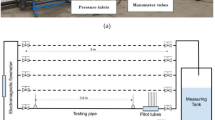Abstract
Applying a thin, protective coating of a nontoxic, chemically resistant epoxy to the interior of existing pipes is an alternative method to pipe replacement. In order to find the controlling parameters in this method, in this study, viscous epoxy was propelled by compressed air through clear polyvinyl chloride (PVC) pipes. Epoxy flow was annular, and it hardened to form a thin, uniform coating on the inner pipe surface. A video camera was employed to record fluid motion, and the thickness of the coating was measured using an image analysis program named ImagJ. Tests were done with varying air temperature, airflow rate, piping configuration, and epoxy temperature. A one-dimensional numerical algorithm was developed to model fluid flow, heat transfer, and epoxy curing. Heating the epoxy makes it move faster because liquid viscosity decreases with increasing temperature. The coating was significantly thicker at the bottom of a horizontal pipe than at the top due to sagging of the epoxy coating after it had been applied, resulting in flow from the top to the bottom of the pipe. Sagging could be reduced by maintaining airflow until curing was almost complete and the epoxy had hardened enough to prevent it from moving easily. The combination of the experimental results and numerical modeling showed that the most important parameters controlling the speed of the epoxy and coating thickness were the air flow rate and temperature, since they determine the shear forces on the epoxy layer and the rate at which the epoxy cures. Raising air temperature increases the reaction rate and therefore decreases the time required for the epoxy to cure inside the pipe. The results of the simulation showed a very good agreement with the experimental results in pipes with 1-in diameter or less.















Similar content being viewed by others
Abbreviations
- A :
-
Frequency factor [s−1]
- C p :
-
Heat capacity [W/kg K]
- E a :
-
Activation energy [J/mol]
- f :
-
Friction factor between air and epoxy
- h :
-
Convection heat transfer coefficient [W/m2 C]
- H :
-
Thickness of epoxy [m]
- H R :
-
Heat of reaction [J/kg]
- k :
-
Thermal conductivity [W/m K]
- K r :
-
Reaction constant [s−1]
- n :
-
Order of reaction
- Nu :
-
Nusselt number
- Pr :
-
Prandtl number
- q :
-
Volumetric heat generation [W/m3]
- Q :
-
Volumetric flow rate [m3/s]
- R :
-
Pipe radius open to air [m]
- Ra :
-
Rayleigh number
- R u :
-
Universal gas constant [J/mol K]
- t :
-
Time [s]
- T :
-
Temperature [K]
- V :
-
Velocity [m/s]
- x :
-
Cartesian axis direction [m]
- y :
-
Cartesian axis direction [m]
- α :
-
Curing degree of epoxy
- τ 0 :
-
Shear stress [kg/m2]
- δ :
-
Thickness [m]
- ρ:
-
Density [kg/m3]
- μ:
-
Dynamic viscosity [kg/s m]
References
Middleman, S, Modeling Axisymmetric Flows: Dynamics of Films, Jets, and Drops. Academic Press, San Diego, CA, 1995
Behzad, T, Sain, M, “Cure Study of an Acrylic Resin to Develop Natural Fiber Composites.” J. Appl. Polym. Sci., 92 757–762 (2004)
Salla, JM, Ramis, X, “A Kinetic Study of the Effect of Three Catalytic Systems on the Curing of an Unsaturated Polyester Resin.” J. Appl. Polym. Sci., 51 453–462 (1994)
Martín, JL, Cadenato, A, Salla, JM, “Comparative Studies on the Non-Isothermal DSC Curing Kinetics of an Unsaturated Polyester Resin Using Free Radicals and Empirical Models.” Thermochim. Acta, 306 (1–2) 115–126 (1997)
Chu, F, McKenna, T, Lu, S, “Curing Kinetics of an Acrylic Resin/Epoxy Resin System Using Dynamic Scanning Calorimetry.” Eur. Polym. J., 33 (6) 837–840 (1997)
Çengel, YA, Heat Transfer: A Practical Approach, p. 418. McGraw Hill, New York, NY, 1997
Streeter, VL, Wylie, EB, Bedford, KW, Fluid Mechanics. McGraw-Hill, New York, NY, 1998
Author information
Authors and Affiliations
Corresponding author
Rights and permissions
About this article
Cite this article
Lin, E., Parizi, H.B., Pourmousa, A. et al. Coating the inner surfaces of pipes with high-viscosity epoxy in annular flow. J Coat Technol Res 8, 697–706 (2011). https://doi.org/10.1007/s11998-011-9361-y
Published:
Issue Date:
DOI: https://doi.org/10.1007/s11998-011-9361-y




